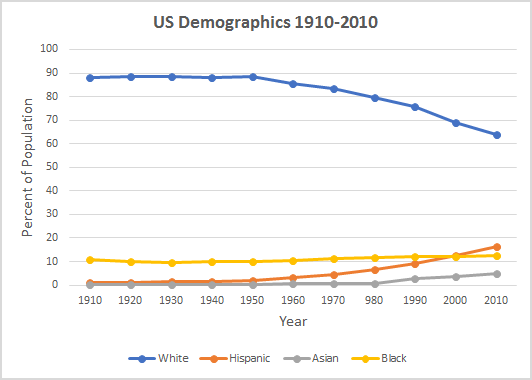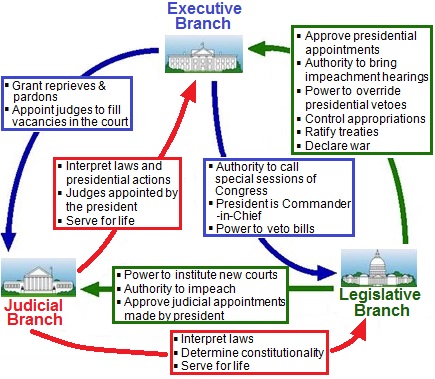Below is our first free GED Social Studies Practice Test, which has been fully updated for the 2024 GED. Topics covered will include Civics, Government, U.S. History, Economics, and Geography. To prepare for your test, be sure to work through as many GED Social Studies practice questions as possible. Our free online test is designed to be very similar to the actual social studies test. Start your test prep right now!
Congratulations - you have completed .
You scored %%SCORE%% out of %%TOTAL%%.
Your performance has been rated as %%RATING%%
Your answers are highlighted below.
Question 1 |
The following are excerpts from the US Constitution:
Article 1, Section 8 – “The Congress shall have Power To... raise and support Armies… To provide and maintain a Navy… to provide for organizing, arming, and disciplining, the Militia.”
Article 2, Section 2 – “The President shall be Commander in Chief of the Army and Navy of the United States, and of the Militia of the several States.”
Article 2, Section 2 – “The President shall be Commander in Chief of the Army and Navy of the United States, and of the Militia of the several States.”
Which fundamental principle of US democracy do these excerpts reflect?
Federalism | |
Limited Government | |
Separation of Powers | |
Judicial Review |
Question 1 Explanation:
Separation of powers refers to the division of government responsibilities into different branches. The purpose is to prevent the concentration of power and provide for checks and balances.
Question 2 |
The graph below shows data from the United States census.

Based on this data, which of the following statements is true?
In 2010, Hispanics were the largest non-white population group. | |
In 2010, whites accounted for less than half of the US population. | |
In 2010, blacks were the smallest population group in the US. | |
In 2010, Asians were the largest non-white population group. |
Question 2 Explanation:
The non-white population groups include hispanic, asian, and black. The orange line represents hispanics, and in 2010 it is clearly higher than the other two lines.
Question 3 |
The following is an excerpt from the The Declaration of Independence:
...whenever any Form of Government becomes destructive of these ends, it is the Right of the People to alter or to abolish it, and to institute new Government, laying its foundation on such principles and organizing its powers in such form, as to them shall seem most likely to effect their Safety and Happiness.
In the excerpt, what does the term abolish mean?
validate | |
change | |
eliminate | |
ignore |
Question 3 Explanation:
In this excerpt, abolish is used to describe eliminating or dissolving a government that is infringing upon citizens’ rights. The founding fathers acknowledged that doing so should be attempted only after efforts to alter or change the status quo had failed. Furthermore, should a government be abolished, it was the responsibility of the people to then create a government that better suited the needs and rights of its citizens.
Question 4 |
The chart below shows US election data from 2016.

Which statement about the popular vote in the 2016 presidential election is supported by the data in the table?
Donald Trump received a majority of the popular vote. | |
Hilary Clinton received a majority of the popular vote. | |
No candidate received a majority of the popular vote. | |
Donald Trump would have received a majority of the popular vote if he had received all of Johnson’s support. |
Question 4 Explanation:
Hillary Clinton won a plurality of the popular vote, meaning that she won more popular votes than any other candidate. But she did not win a majority of the popular vote because she did not win more than 50%. No candidate won over 50%, so no candidate won a majority.
Question 5 |
Consider the following statements:
When prices rise, supply increases. When prices fall, supply decreases. When prices increase, demand falls. When prices fall, demand increases.
Which of the following is true?
Farmers will produce additional beans when the price per ton goes down by $10. | |
Manufacturers will produce more tires when the price per tire goes up by $8. | |
Consumers will buy more apples when the price per dozen goes up by $1.50. | |
Consumers will buy less ice cream when the price per carton goes down by $1. |
Question 5 Explanation:
This is a case of rising prices leading to increase suppy. When the price of tires goes up, manufacturers will work to produce more tires in order to profit from these high prices. Over time, this increased production will start to push prices back down.
Question 6 |
Review the following timeline:
- 1932 – FDR is elected to his first term as president.
- 1933 – FDR signs a law repealing Prohibition.
- 1936 – FDR is elected to a second term in office.
- 1940 – FDR is elected to a third term in office.
- 1941 – Japan attacks Pearl Harbor and the US enters WWII.
- 1944 – FDR is elected to a fourth term in office.
- 1945 – The US wins WWII.
- 1947 – The 22nd Amendment is introduced which limits presidents to two four-year terms.
What conclusion is supported by the information in the timeline?
The 22nd Amendment was a response to FDR’s unprecedented four terms in office. | |
The attack on Pearl Harbor helped FDR win a third term in office. | |
FDR failed to fulfill a campaign promise to repeal Prohibition. | |
Voters elected FDR to a fourth term in order to show their appreciation for victory in WWII. |
Question 6 Explanation:
The timeline shows that FDR was elected as President four times, and then the 22nd Amendment was introduced. It is reasonable infer that this Amendment was a response to FDR's four terms. There is no evidence supporting any of the other claims.
Question 7 |
Three of the following statements about the Korean War are based on facts and evidence. Which one is based on speculation or opinion?
More than 34,000 American soldiers died during the Korean War. | |
The Korean War was the first time jet fighters faced each other in combat. | |
The United States may have won the Korean War if General Douglas MacArthur had been permitted to use nuclear weapons against Communist forces. | |
The Korean War began in 1950 and ended with an armistice in 1953. |
Question 7 Explanation:
This statement is speculating about how an historical event might have played out differently under altered circumstances. There is no way to prove this factually.
Question 8 |
Questions 8–9 refer to the following chart:

Which branch of government approves new judges to serve on the Supreme Court?
The Judicial Branch | |
The Legislative Branch | |
The Executive Branch | |
The Voters |
Question 8 Explanation:
As shown in the chart, the Executive Branch appoints judges and the Legislative Branch approves judicial appointments.
Question 9 |

The chart best illustrates which of the following principles?
Federalism | |
Popular Sovereignty | |
Judicial Review | |
Checks and Balances |
Question 9 Explanation:
The American government utilizes a system of checks and balances that enables each branch of government to oversee and exert some control over the actions of the other branches. This system is meant to prevent any single branch from acting autonomously, thereby preventing a centralization of power. The diagram shows that each branch of government is influenced by, and can influence, each of the other branches.
Question 10 |
Examine the poster and answer the question that follows.

This World War II poster served what function:
Encourage protest against the war. | |
Promote support for the war. | |
Encourage the Axis powers to end the war. | |
Demonstrate the ineffectiveness of guns. |
Question 10 Explanation:
While men were on the battle lines, women were encouraged to contribute to the war effort by participating in factory work and other jobs traditionally held by men.
Once you are finished, click the button below. Any items you have not completed will be marked incorrect.
There are 10 questions to complete.
|
List |
Next Practice Test:
GED Social Studies Practice Test 2 >>
